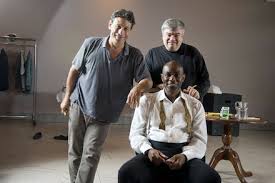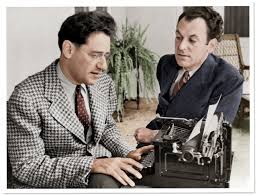 Am I nervous about the fast-approaching opening night of Satchmo at the Waldorf? Knowing what I know about the utter unpredictability of the theater business, I’d be crazy if I weren’t. Mostly, though, I just walk around feeling slightly distracted. It isn’t exactly a pleasant sensation, but it could be a whole lot worse. (It’s a good thing, though, that I’m not driving anywhere these days. I shudder at the thought of finding myself behind the wheel of a car right now.)
Am I nervous about the fast-approaching opening night of Satchmo at the Waldorf? Knowing what I know about the utter unpredictability of the theater business, I’d be crazy if I weren’t. Mostly, though, I just walk around feeling slightly distracted. It isn’t exactly a pleasant sensation, but it could be a whole lot worse. (It’s a good thing, though, that I’m not driving anywhere these days. I shudder at the thought of finding myself behind the wheel of a car right now.)
This isn’t to say that I’m confident that Satchmo will go over in New York. I’m not, to put it very, very mildly, even though the previews have gone well so far. But I believe that I’ve done my best, such as it is, and I know that I have a singularly gifted star and director. So insofar as I can think about other things, I do. When I can’t, I work, and when I haven’t any work to do, I go to the Westside Theatre and hang out. It’s a comforting place to be, a windowless chamber cut off from the outside world whose busy occupants are wholly dedicated to the gratifying task of ensuring that the off-Broadway transfer of my first play looks and sounds as good as is humanly possible.
The closer we get to March 4, the better I see how accurately Moss Hart described what I’m feeling right now in Act One, his 1959 autobiography. It tells the stomach-churning story of how he collaborated with George S. Kaufman on Once in a Lifetime, a comedy that opened on Broadway in 1930 after much preliminary chaos and made the twenty-five-year-old Hart a celebrity in a single stroke of good fortune (preceded by a grueling year of appallingly hard work). The book describes in excruciating detail every setback and sleepless night that stood between the writing of the first draft of Once in a Lifetime and the publication of the reviews that turned it into a hit. It’s a wonderful, terrible tale whose happy ending redeems all the horrors that lead up to it.
 James Lapine, as it happens, has just turned Act One into a play, and his stage version open at Lincoln Center Theater later this season. I can’t wait to see it, not least because I’ll know by then whether Satchmo at the Waldorf is a hit, a flop, or something in between.
James Lapine, as it happens, has just turned Act One into a play, and his stage version open at Lincoln Center Theater later this season. I can’t wait to see it, not least because I’ll know by then whether Satchmo at the Waldorf is a hit, a flop, or something in between.
I read Act One for the first time when I was a teenager. I’d just joined the high-school drama club, and Hart’s tales of theatrical derring-do filled me with dreams of a life on the stage, dreams that were soon supplanted by a different, more practical set of music-related fantasies. To be sure, I continued to work on shows until I graduated from college, but then I put the theater behind me–permanently, I assumed.
Even after I became the drama critic of The Wall Street Journal, it never occurred to me, not even for a moment, that a time would come when I’d know exactly how Moss Hart felt as he waited for Once in a Lifetime to open:
I walked toward Once in a Lifetime for the last time–that final walk every playwright takes toward his play, knowing that it is no longer his, that it belongs to the actors and the audience now, that a part of himself is to be judged by strangers and that he can only watch it as a stranger himself. The main consideration of his day, the keystone that has dictated his every waking moment, the cause that has enlisted his being for all these months, is at an end. He moves toward his destination with mixed emotions–it is the completion he has sought, but there is the ache of finality in it. He is at last a spectator–a spectator with the largest stake in the gamble of the evening, but a spectator nonetheless.
No, it isn’t pleasant. But like I said, it could be worse.
